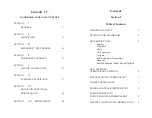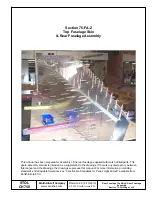
34
Section 5
Flying the Sting 2
Recovery
To recover, release the speed bar, wait until
the wing has slowed down and let go of both
A-risers. Assist the opening process by a
short, impulsive pumping motion with the
brakes if the ears do not open automatically.
Landing
There are no specific characteristics to
observe during landing. Prepare for landing
by making a straight approach flight into the
wind and allow the glider to decelerate at
trim speed. At 1m above the ground, the
brake lines are pulled down as far as they
will go, so that the paraglider has been fully
braked just before the ground is reached.
The brakes should be applied in a more
regulated manner if there is a strong
headwind. Landing out of a steep turn or a
rapid change of direction before landing
should be avoided because of the pendulum
effect caused.
Winch launch
The procedure for a winch launch is similar
in its initial stages to a forwards launch. After
the canopy has been pulled up to its highest
point, the pilot rises from the ground by the
tension of the tow line. Under no
“ ”
and
be given before the glider is completely
under control. Major changes to direction
should be avoided during the launch phase
and before reaching a safe altitude. After
having left the ground, the pilot will be slowly
towed in a flat angle up to the safe altitude of
50m. During this phase, the pilot must
remain ready to run and must not sit back in
the harness, so that it is possible to land
safely in the event that the winch or tow rope
fails. Ensure that the glider is flown with
open brakes so that the angle of attack is
not increased further by the brakes.
On a winch launch, the glider should if
possible be steered only by weight-shifting.
Brisk, forceful steering input with the brakes
can be used to help correct direction, without
braking the glider too much and stalling it.
WARNING
The technique of big ears causes a higher
load for the line groups which are still
weight-bearing. Therefore, do not fly any
extreme manoeuvres with big ears.
This manoeuvre should be avoided in low
temperatures. Pilots should be aware that
this increases the tendency to deep stall.
WARNING
Always fly with sufficient speed when you
are near the ground (well above stall
speed) to avoid an unintentional stall.
WARNING
The most common cause of stall on winch
is releasing the A-risers too early while
the glider is rising. The pilot should
ensure that the canopy is above him
“ ” .
Any changes to direction using the brakes
should not be carried out until the canopy
is already above the pilot, as too much
brake can cause the glider to fall down
again or be towed in a non-flyable
condition.
Summary of Contents for Powerplay Sting 2
Page 1: ...Version 1 0 Date 08 08 2014 Instruction Manual EN ...
Page 55: ...Notes ...
















































